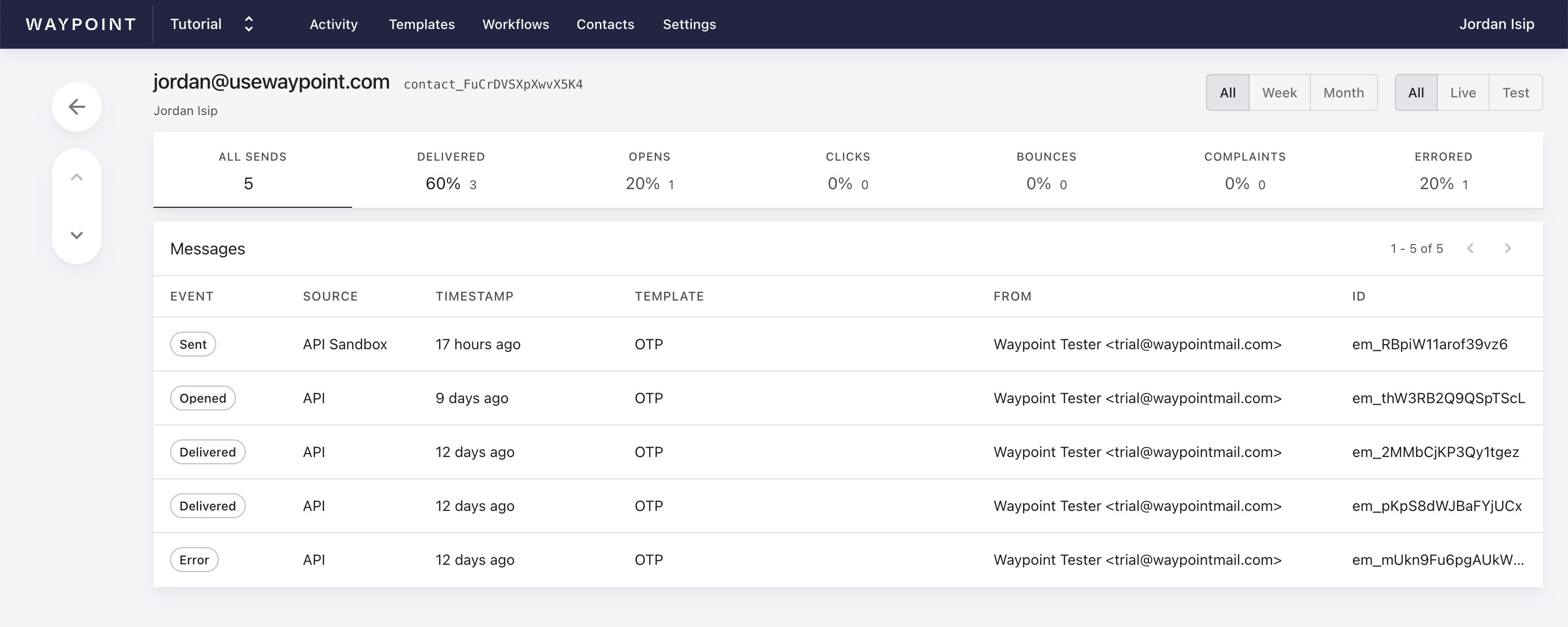SendGrid email API alternative
Feeling dev bottlenecks with SendGrid? Use Waypoint for a new approach to divide and conquer the workload.
In this article, we’re comparing Waypoint vs SendGrid email API platforms.
High level comparison
Section titled “High level comparison”Before we get started, it’s important that we clarify that both platforms are great options for reliable email delivery at scale. Each service simply has different approaches and, therefore, prioritize things differently.
Also worth clarifying, SendGrid offers two main products with two different pricing plans: An email API software for transactional emails, and marketing campaign software for email blasts. For this comparison we’ll only be looking at SendGrid’s email API product as Waypoint is intentionally only focused on transactional emails.
SendGrid is the juggernaut in the email API space. It’s a popular and well established email delivery service that has been around since 2009.
Waypoint is the upstart in the space with similar email API offerings but with new approaches to collaboration and observability.
Why software teams choose Waypoint over SendGrid
Section titled “Why software teams choose Waypoint over SendGrid”1. A more powerful dynamic template builder
Section titled “1. A more powerful dynamic template builder”While SendGrid has a dynamic email template builder, it can fall flat when working with data-rich transactional email templates.This is because SendGrid (and other marketing tools) repurposes it’s marketing email template builder that is geared for little to no dynamic data for their transactional emails.
Waypoint, on the other hand, is designed specificially for data rich transactional emails. This means a block-based template builder that is powerful enough to handle liquid templating, conditional hiding, loops, test data scenarios, reusable layouts, and more - all visually and without any code. It’s approach to designing also enables a more WYSIWYG experience. Compare the builders below:

The difference is even more pronounced when doing more advanced templating. In the example below, Waypoint has a way to visually build loops and conditionals while SendGrid requires Handlebar templating code and HTML.

2. High deliverability, even on lower paid tiers
Section titled “2. High deliverability, even on lower paid tiers”SendGrid (and most other email API platforms) put free and lower paid tier accounts on shared IP pools. This means that if a spammer joins a free plan, there is risk that they can ruin the reputation of other platforms in the shared IP pool. This causes IP addresses to get blacklisted and emails landing in spam instead of inboxes.
Waypoint takes a different path by not offering a free plan at all. This level of curation helps ensure that those that pay for even the lowest starter plan on Waypoint have high deliverability rates.
3. Less expensive at scale
Section titled “3. Less expensive at scale”Waypoint has simple straightforward pricing and is similar in price to SendGrid’s paid plans at the lower volumes and less expensive at higher volumes. Price comparison examples (at the time of publishing this article):
| Emails per month | Waypoint | SendGrid email API |
|---|---|---|
| 10,000 | $20 | $19.95 |
| 300,000 | $250 | $249 |
| 1,000,000 | $437 | $602 |
Per month price comparision
4. Less expensive for teams
Section titled “4. Less expensive for teams”As soon as you have more than one teammate with workspace access, SendGrid requires their pro plan starting at $89.95/mo. Waypoint is designed for collaboration so teams can invite unlimited teammates, even on the starter plan.
| Teammates | Waypoint | SendGrid email API |
|---|---|---|
| 1 | $20 | $19.95 |
| 2-1000 | $20 | $89.95 |
| 1000+ | $20 | Custom |
5. Better logs
Section titled “5. Better logs”Another key difference is Waypoint’s capabilities for observability. Unlike other platforms where transactional emails are secondary, Waypoint provides a full log of the entire email content, raw HTML, template data, metadata, and event timeline for each email. SendGrid only provides metadata and the event timeline (see below). This is especially helpful for debugging and monitoring emails.

Additionally, unlike SendGrid, Waypoint allows for drilling down to logs on the individual contact level to see a full timeline of events per contact.

6. Unmatched, real human support
Section titled “6. Unmatched, real human support”Waypoint is dedicated to incredible customer support and most often, you’ll be talking directly to one of our founders. Great support for each of our customers comes standard. A dedicated account manager on SendGrid is thousands of dollars per month.
Why teams might consider SendGrid over Waypoint
Section titled “Why teams might consider SendGrid over Waypoint”Having said all of the above, you may be wondering why your team might consider SendGrid? The main advantage of SendGrid is that it’s been a platform that has been evolving over the past decade.
This means SendGrid has certain functionality that Waypoint doesn’t have (which may or may not be a a dealbreaker for your team):
Webhooks(added Nov 2024)- Inbound email parsing
- Email rendering testing across clients
- Sub user management (credit limits on users)
- Advanced contact segmentation
- SMTP relays
- Single Sign On (SSO)
However, we’ll add that many of these advanced features are on Waypoint’s roadmap and we’re building fast.
Conclusion
Section titled “Conclusion”We encourage you to give both products a try for yourself to see which one may be the best fit for your team. While both products have many overlapping features, each service has it’s own personality and priorities.
However, we think you’ll love Waypoint for transactional emails, especially when collaborating with a growing team. Our customers believe so as well:
“Waypoint team and support surpassed our expectations, ensuring a seamless transition from SendGrid. Their liquid templating simplified the conversion of our existing emails, and since migrating, their service has been flawless. Our emails no longer end up in spam folders, leading to an impressive increase in our onboarding conversion rates. Waypoint’s fast and reliable deliverability has taken our account verification success from below 50% to nearly 100%.”
– Dallin Dyer (CTO of Dree.com)